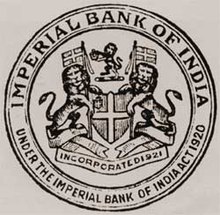Imperial_Bank_of_India
Imperial Bank of India
Former central bank of India before 1935
The Imperial Bank of India (IBI) was one of the oldest and the largest commercial bank in India, and was subsequently renamed and nationalised as the State Bank of India in 1955. Initially, as per its royal charter, it acted as the central bank for India prior to the formation of the Reserve Bank of India (RBI) in 1935.
This article includes a list of general references, but it lacks sufficient corresponding inline citations. (February 2019) |
